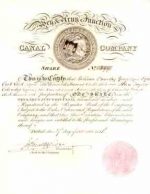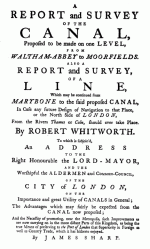What factors made the development of the canal network possible?
How Canal Development Became Possible
The existing canals were busy. Demand for coal, stone, grain, and manufactured goods continued to grow. This encouraged people to support more canal schemes. Coal production rose from 5.2 million tons in 1750 to 15 million tons in 1800 and 45 million in 1830.
After the Duke of Bridgewater's great success, others quickly followed in a "canal mania". Every investor, instead of being wary of buying shares in a canal, wanted to share the profits. For example at a meeting of subscribers to the Rochdale Canal in 1791 £53,000 was immediately raised, and three times as much could have been invested.
Most canals after the Bridgewater were run by companies. Previously only wealthy individuals like the Duke were able to run big businesses. Companies were formed by issuing shares. The people buying the shares contributed the money for the company to build the canal and owned a part of the company. They also shared the profits.
Some of the shareholders, or part-owners, of the company, are listed below:
Duke of Marlborough - £5,000 (50 shares)
Marquis of Blandford - £5,000 (50 shares)
R Newdigate - £2,000 (20 shares)
F. Page - £2,000 (20 shares)
Lord C Spencer - £2,000 (20 shares)
Lord R. Spencer - 20 shares - £2,000
James Brindley - 20 shares - £2,000
Nathan Wetherell, Vice Chancellor,
Oxford University - £2,000 (20 shares)
Oxford City Council - £1,800 (18 shares)
Others all together - £126,200 (1262 shares)
When the company made a profit, the profits could be distributed to the shareholders, who owned it, in proportion to the number of shares each of them owned. This is called a "dividend". The basic principle of company organisation remains the same today. The canal companies were amongst the first organisations to be formed in this way.
Some of the shareholders, or part-owners, of the company, are listed below:
Duke of Marlborough - £5,000 (50 shares)
Marquis of Blandford - £5,000 (50 shares)
R Newdigate - £2,000 (20 shares)
F. Page - £2,000 (20 shares)
Lord C Spencer - £2,000 (20 shares)
Lord R. Spencer - 20 shares - £2,000
James Brindley - 20 shares - £2,000
Nathan Wetherell, Vice Chancellor,
Oxford University - £2,000 (20 shares)
Oxford City Council - £1,800 (18 shares)
Others all together - £126,200 (1262 shares)
When the company made a profit, the profits could be distributed to the shareholders, who owned it, in proportion to the number of shares each of them owned. This is called a "dividend". The basic principle of company organisation remains the same today. The canal companies were amongst the first organisations to be formed in this way.
Engineers had built long tunnels and aqueducts. This gave people the confidence to support new engineering schemes. More engineers, such as Telford, Rennie and Jessop developed the techniques of canal building pioneered by Brindley.
The early canal engineers such as Brindley had trained assistants. Some of these went on to become canal engineers. More skilled engineers were therefore available to build more canals. For example Robert Whitworth was one of Brindley's assistants and he completed a number of canals. He surveyed the route for a canal in London which was never built.






